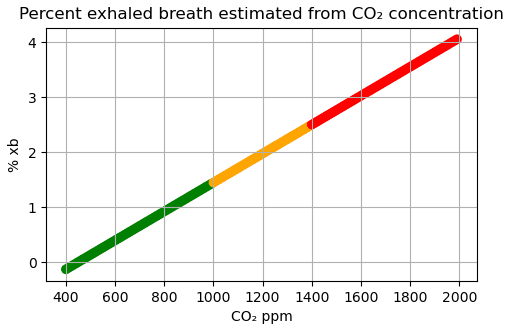Frequently Asked Sensor Questions

How long does the sensor battery last?
The battery lasts more than two weeks, and is shipped already charged. From dead, it recharges in two hours using a standard USB-C cable. While plugged in, the LED slowly flashes red (even when powered off).
The app can display current sensor battery level, and it notifies you when it falls below 30%.
How do I turn on the sensor?
Unplug the sensor before pressing the button, so the charging light signal does not interfere with other light signals.
To power sensor on, hold button down for 3 seconds. The light will flash once red and once green. The light remains off to conserve power, even while the device is powered on and operating.
What else can the button do?
When unplugged and powered on, a single short click starts an immediate CO₂ measurement. Wait while the LED flashes blue as it conducts a measurement. When measurement is complete, the LED glows solid green (or yellow or red) to indicate the aproximate result, and a precise reading can be retrieved from the app.
To power the sensor off, hold the button down for 5 seconds. The light will quickly flash red 8 times before turning off. Then the device stops measuring and stops communicating with the app until it is turned on again. To help the sensor remain calibrated, do not turn it off, even while charging. This device is designed to remain powered on all the time.
How can it measure air from inside my pocket?
The airCoda Pocket Sensor does not measure particulate matter -- it measures gases. CO₂ and VOCs diffuse readily through typical clothing fabrics, so the device works well from inside most pockets and bags (but not a sealed plastic bag). One advantage to wearing it in your pocket rather than on a lanyard is that you are less likely to breathe on it directly.
Upon entering a new space, it should take only a few minutes for gas concentrations in your pocket to equalize with that of the surrounding room. Our tests have shown rapid changes in CO₂ concentration are delayed by less than 10 minutes inside a zipped-up leather purse.
What kind of sensors are in the airCoda Pocket Sensor?
A photoacoustic NDIR sensor measures carbon dioxide, and a MOx-based resistive sensor measures volatile organic compounds. The package also includes temperature and humidity sensors for signal compensation to provide high accuracy at small size and low power consumption.
Is CO₂ dangerous?
Carbon dioxide is not toxic even at the "red" levels indicated by the app, but it indicates poor indoor ventilation. When multiple people are in the room at these levels there is greater risk of infectious disease transmission [1]. Cognitive performance and reaction times are also significantly reduced compared to levels in the "green" zone [3, 5].
How is percentage of exhaled breath estimated?
The difference between indoor and outdoor CO₂ concentrations is typically due solely to exhaled breath [1].

exhaled_breath = (measured_co2 - ambiant_co2) / breath_co2
On this chart, a 25% increase of CO₂ concentration from 800ppm to 1200ppm indicates double the estimated concentration of exhaled breath, and potentially double the risk of infectious disease transmission.
What other indoor air polutants are detected?
The TVOC sensor detects a wide range of toxic volatile organic compounds, including
- Formaldehyde - in disinfectants, furniture upholstery, carpets
- Benzene - in tobacco smoke, paint thinner, deodorizers, air "fresheners"
- Methylene chloride - in spot removers, commercial solvents, refrigerants
- Tetrachloroethylene - in solvents, dry cleaning, paint strippers
- Toluene - in paint, metal cleaners, adhesives
What is the VOC index?
The VOC index as defined by Sensirion [2] is a number ranging from 1 to 500 where 100 represents the sensor's average VOC baseline sensed over the last 24 hours. Numbers below 100 are lower than average, and numbers above 100 are higher than baseline. The airCoda app displays the percentage above or below this baseline.
How does the device connect to my phone?
The airCoda app reads the latest measurements from the Pocket Sensor over Bluetooth. Your device should remain in the same room as your phone, and the app must stay running in the background to monitor air quality while your phone screen is off.
How often does it record a measurement?
The Pocket Sensor takes a measurement about every 200 seconds. When you open the airCoda app, it immediately shows you the latest reading. The app also runs periodically in the background, but how often the app records a measurement depends on several factors. You can tell the app to limit update frequency (e.g. 3 to 16 max points per hour), but the operating system also limits updates, based on battery state, memory state, and other settings. To keep the app running frequently in the background, it helps to open it a few times a day, or your operating system might decide to stop running it in order to save resources.
What are its size and weight?
- Dimensions: 40 x 60 x 13mm (1.9 cubic inches)
- Weight: 26g (0.9 oz)
APP FAQ
Frequently Asked App Questions >>References
[1] Rudnick and Milton, 2003, "Risk of indoor airborne infection transmission estimated from carbon dioxide concentration", Indoor Air, 2003 https://europepmc.org/article/med/12950586
[2] Sensirion AG, "What is Sensirion's VOC Index"
[3] Allen, Joseph G., et al. "Associations of cognitive function scores with carbon dioxide, ventilation, and volatile organic compound exposures in office workers: a controlled exposure study of green and conventional office environments." Environmental health perspectives 124.6 (2016)
[4] U.S. Environmental Protection Agency. 1989. Report to Congress on indoor air quality: Volume 2. EPA/400/1-89/001C. Washington, DC.
[5] Palacios, Juan and Eichholtz, Piet and Kok, Nils and Duran, Nicolas, Indoor Air Quality and Learning: Evidence from A Large Field Study in Primary Schools (December 7, 2022). MIT Center for Real Estate Research Paper No. 22/13
